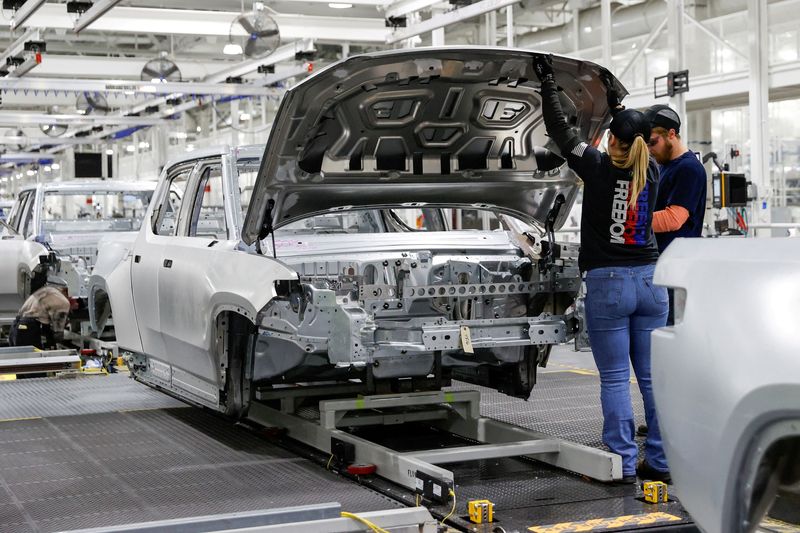By Lucia Mutikani
WASHINGTON (Reuters) - U.S. job openings decreased in October, but remained significantly high, pointing to continued labor market resilience despite the Federal Reserve's efforts to cool demand by aggressively raising interest rates.
The tight labor market keeps the Fed on course to continue tightening monetary policy, heightening the risks of a recession next year. Most economists, however, believe any downturn will likely be short and mild because of the unprecedented jobs market strength.
Fed Chair Jerome Powell said on Wednesday the U.S. central bank could scale back the pace of its rate increases "as soon as December," but cautioned that the fight against inflation was far from over.
"Elevated job openings during a time of an economic slowdown implies that the labor market may remain tight for quite some time," said Jeffrey Roach, chief economist at LPL Financial (NASDAQ:LPLA) in Charlotte, North Carolina. "Firms could hoard workers even though the economy may go through a recessionary period."
Job openings, a measure of labor demand, decreased 353,000 to 10.3 million on the last day of October, the Labor Department said in its monthly Job Openings and Labor Turnover Survey, or JOLTS report. It was the 16th straight month that job openings remained above 10 million.
October's job openings were in line with economists' expectations. There were 1.7 job openings for every unemployed person in October, down from 1.9 in September. Last month's decrease in job openings was led by state and local government, excluding education, where vacancies dropped by 101,000.
There were 95,000 fewer job openings in nondurable goods manufacturing, while federal government vacancies fell by 61,000. But there were 76,000 additional job openings in other services and unfilled positions increased by 70,000 in the finance and insurance industry.
The job openings rate fell to 6.3% from 6.5% in September. Hiring slipped to 6.0 million from 6.1 million in September.
The Fed's Beige Book on Wednesday found that while difficulties hiring and retaining workers continued to ease, "labor markets were still described as tight."
Mounting recession fears appear to have taken some of the steam out of the great resignation movement. About 4.0 million people quit their jobs, down from 4.1 million in September.
The quits rate, viewed by policymakers and economists as a measure of job market confidence, fell to 2.6% from 2.7% in the prior month. Layoffs increased to a still-low 1.4 million from 1.3 million, leaving the layoffs rate unchanged at 0.9%.
"The data suggest only very little loosening in the labor market so far," said Isfar Munir, an economist at Citigroup (NYSE:C) in New York. "It will be difficult for the Fed to be anything but hawkish at the moment."
The U.S. central bank has raised its policy rate by 375 basis points this year from near zero to a 3.75%-4.00% range in what has become the fastest rate-hiking cycle since the 1980s. Economists expect half-a-percentage point increase at the Dec. 13-14 meeting.
U.S. stocks rallied on Powell's comments. The dollar fell against a basket of currencies. U.S. Treasury prices rose.
GRAPHIC - JOLTS
https://graphics.reuters.com/USA-STOCKS/dwpkdrnyqvm/jolts.png
GROWTH REVISED UP
The elevated level of job openings also suggests worker shortages persist, which economists said were contributing to the slowdown in job growth. Private employment increased by 127,000 jobs in November, the smallest gain since January 2021, the ADP National Employment report showed on Wednesday.
GRAPHIC - ADP
https://graphics.reuters.com/USA-STOCKS/lbpggndylpq/adp.png
Labor market strength is helping to drive consumer spending, supporting the overall economy. A fourth report from the Commerce Department showed the economy rebounded more strongly than initially thought in the third quarter.
Gross domestic product increased at a 2.9% annualized rate, the government said in its second estimate of third-quarter GDP. That was revised up from the 2.6% pace reported last month. The economy had contracted at a 0.6% rate in the second quarter.
The upward revision reflected upgrades to growth in consumer and business spending as well as exports, which offset the drag from a slower pace of inventory accumulation. But residential investment contracted for the sixth straight quarter, the longest such stretch since the housing market collapse in 2006.
GRAPHIC - GDP consumer spending
https://graphics.reuters.com/USA-STOCKS/lgpdkwegjvo/GDPconsumer.png
When measured from the income side, the economy grew at a 0.3% rate. Gross domestic income (GDI) had contracted at a 0.8% pace in the second quarter. In principle, GDP and GDI should be equal, but in practice diverge as they are estimated using different and largely independent source data.
The income side of the growth ledger was driven by wages.
The average of GDP and GDI, also referred to as gross domestic output and considered a better measure of economic activity, increased at a 1.6% rate in the July-September period after shrinking at a 0.7% pace in the second quarter.
Profits from current production decreased $31.6 billion in the third quarter after rising $131.6 billion in the second quarter. Profits were, however, impacted by penalties and fines imposed on some businesses by federal and state agencies.
A fifth report from the Commerce Department showed the goods trade deficit surged 7.7% to $99.0 billion last month as exports declined. October's sharp widening in the deficit suggested trade could be a drag on GDP in the fourth quarter.
The Commerce Department also reported that wholesale inventories increased 0.8% in October after rising 0.6% in September. Retail inventories fell 0.2% after dipping 0.1% in September. Motor vehicle stocks increased 0.4%.

Excluding motor vehicles, retail inventories slipped 0.4% after dropping 0.9% in September.
This component goes into the calculation of GDP. Inventories subtracted from GDP growth in the third quarter.
